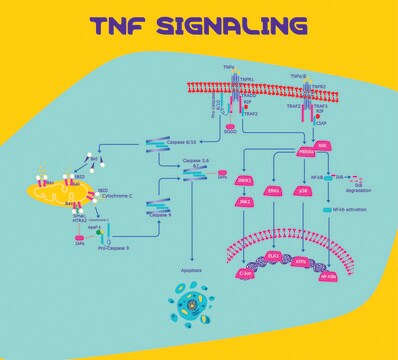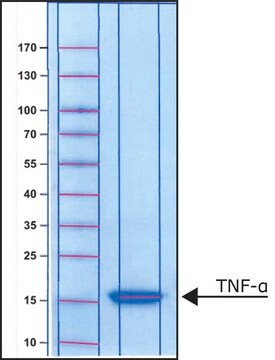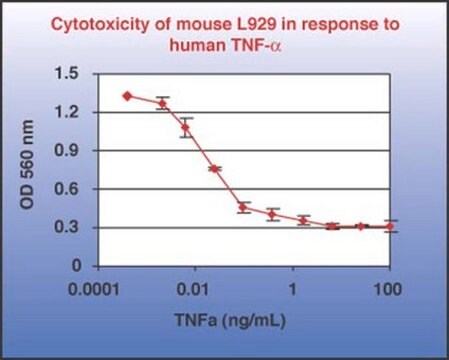654245
TNF-α, Mouse, Recombinant, E. coli
Synonym(s):
rmTNF-α, rm-Cachectin, Tumor Necrosis Factor-α
Sign Into View Organizational & Contract Pricing
All Photos(1)
About This Item
UNSPSC Code:
12352202
NACRES:
NA.32
Recommended Products
biological source
mouse
Quality Level
recombinant
expressed in E. coli
Assay
≥97% (SDS-PAGE)
form
lyophilized
mol wt
17,000 g/mol
manufacturer/tradename
Calbiochem®
storage condition
OK to freeze
technique(s)
cell based assay: suitable
impurities
≤100 pg/μg Endotoxin (pg/μg TNF-α)
shipped in
ambient
storage temp.
−70°C
Gene Information
mouse ... Tnf(21926)
General description
Reasearch area: Apoptosis
Recombinant mouse tumor necrosis factor-α (TNF-α), expressed in E. coli, is known for its direct tumoricidal capabilities. This inflammatory cytokine triggers a cascade of other cytokines and factors constituting the immune system′s response to infections and cancer. Additionally, it has been reported to influence changes in bone metabolism during inflammation. (TNF-α), a homotrimer protein, occurs in a soluble and transmembrane form.
Recombinant mouse tumor necrosis factor-α (TNF-α), expressed in E. coli, is known for its direct tumoricidal capabilities. This inflammatory cytokine triggers a cascade of other cytokines and factors constituting the immune system′s response to infections and cancer. Additionally, it has been reported to influence changes in bone metabolism during inflammation. (TNF-α), a homotrimer protein, occurs in a soluble and transmembrane form.
Application
TNF-α, Mouse, Recombinant, E. coli has been used to study TNF-signaling to insulin gene expression in insulin-producing cells.
Biochem/physiol Actions
TNF-α, a cytokine, interacts with two distinct receptors, initiating signal transduction pathways that result in cellular responses, such as cell survival, differentiation, and proliferation. It regulates inflammatory responses and activates inflammatory molecules, including other cytokines and chemokines. Transmembrane TNF-α binds to TNFR1 and TNFR2 and facilitates inflammation and cell death. However, excessive or inappropriate activation of TNF-α signaling is linked to chronic inflammation and may lead to pathological complications, including autoimmune diseases. Rheumatoid arthritis (RA), inflammatory bowel disease (IBD), psoriatic arthritis (PsA), psoriasis (PS), and noninfectious uveitis (NIU) are few conditions.
Additionally, TNF-α is associated with insulin signaling inhibition. Its removal ameliorates insulin sensitivity. The activity of the Jun N-terminal kinase (JNK) signaling pathway, which is abnormally elevated in obesity, is strongly activated by both TNF-α.
ED₅₀ = 20-50 pg/ml as measured in a cytotoxic assay using the TNF-α susceptible murine L-929 cell line in the presence of Actinomycin D (Cat. No. 114666)
Additionally, TNF-α is associated with insulin signaling inhibition. Its removal ameliorates insulin sensitivity. The activity of the Jun N-terminal kinase (JNK) signaling pathway, which is abnormally elevated in obesity, is strongly activated by both TNF-α.
ED₅₀ = 20-50 pg/ml as measured in a cytotoxic assay using the TNF-α susceptible murine L-929 cell line in the presence of Actinomycin D (Cat. No. 114666)
Warning
Toxicity: Standard Handling (A)
Physical form
Lyophilized from sterile-filtered PBS, 50 µg BSA/µg TNF-α.
Reconstitution
Following reconstitution, aliquot and freeze (-70°C) for long term storage or refrigerate (4°C) for short term storage. Avoid freeze/thaw cycles of solutions. Stock solutions are stable for up to 1 month at 4°C or for up to 3 months at -70°C.
Reconstitute to a concentration ≥10 µg/ml with sterile PBS containing ≥0.1% HSA or BSA.
Other Notes
Scharla, S.H., et al. 1994. Eur. J. Endocrinol. 131, 293.
Eck, M.J., et al. 1992. J. Biol. Chem. 267, 2119.
Eck, M.J., et al. 1992. J. Biol. Chem. 267, 2119.
Legal Information
CALBIOCHEM is a registered trademark of Merck KGaA, Darmstadt, Germany
Storage Class Code
11 - Combustible Solids
WGK
WGK 1
Flash Point(F)
Not applicable
Flash Point(C)
Not applicable
Certificates of Analysis (COA)
Search for Certificates of Analysis (COA) by entering the products Lot/Batch Number. Lot and Batch Numbers can be found on a product’s label following the words ‘Lot’ or ‘Batch’.
Already Own This Product?
Find documentation for the products that you have recently purchased in the Document Library.
Customers Also Viewed
Adilson Guilherme et al.
The Journal of biological chemistry, 284(25), 17082-17091 (2009-03-27)
The nuclear receptor peroxisome proliferator-activated receptor gamma (PPARgamma) is a ligand-dependent transcription factor that acts as a primary regulator of adipogenesis and controls adipocyte metabolism and insulin action. Increased expression of tumor necrosis factor (TNFalpha) in adipose tissue of obese
Our team of scientists has experience in all areas of research including Life Science, Material Science, Chemical Synthesis, Chromatography, Analytical and many others.
Contact Technical Service






